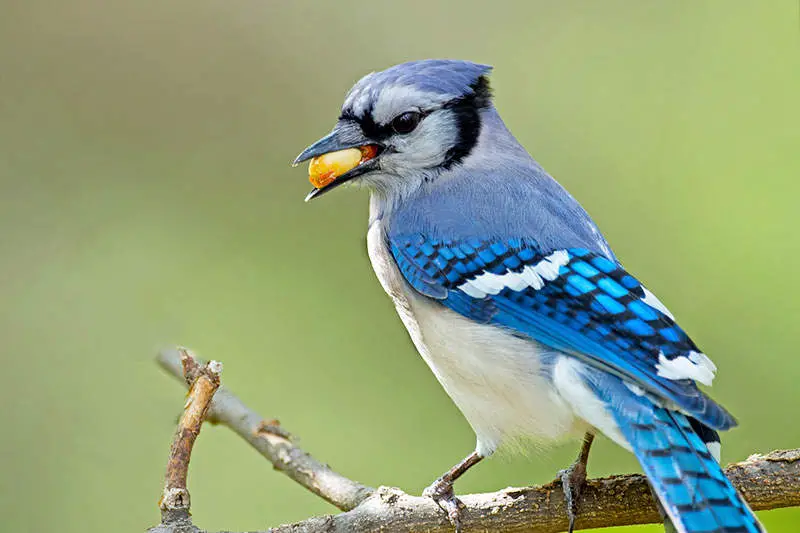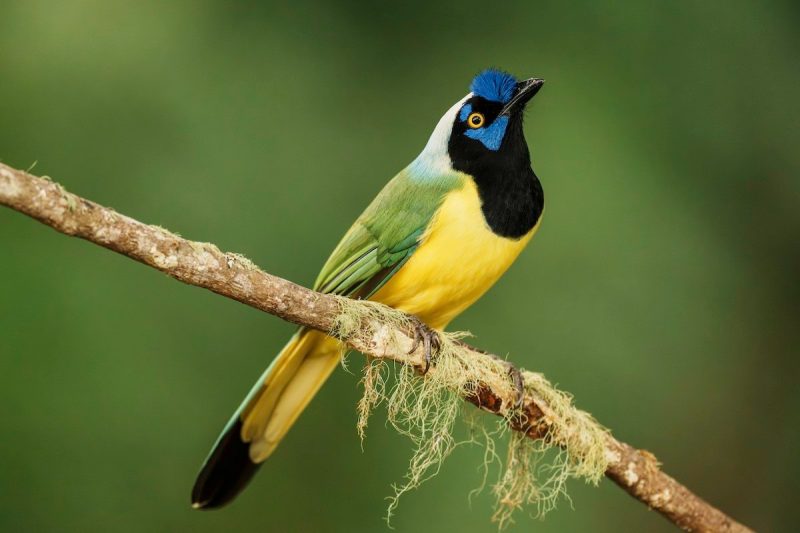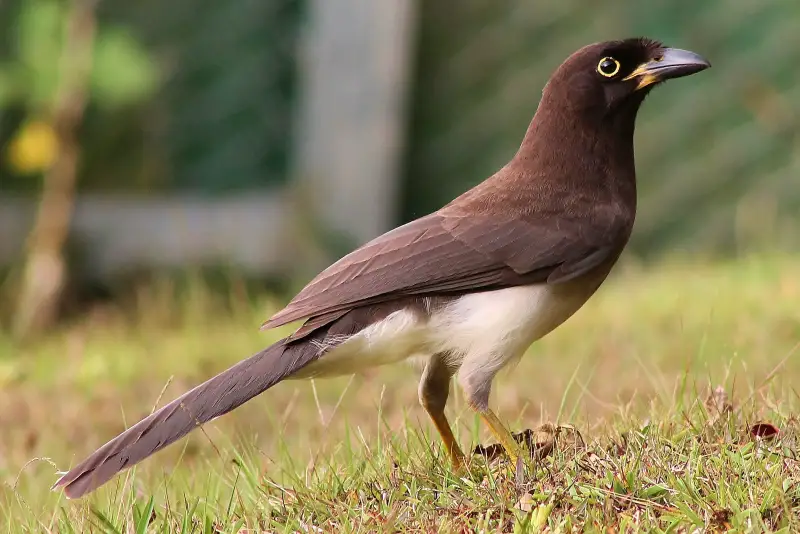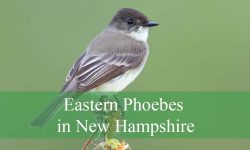With its abundance of bird species, Florida offers a brilliant display of wildlife, and the jays are among its most notable highlights. Known for their intelligence, bold personalities, and vivid plumage, jays bring both sound and color to woodlands, parks, and backyards. While only a couple of jay species are commonly seen in Florida, a few others appear as rare visitors, making them exciting finds for birdwatchers.
In this article, we will explore four types of jays that can be found in Florida. You’ll discover their identifying traits, behavior, habitats, and distribution. Whether you’re a casual bird enthusiast or a dedicated birder, this guide will help you spot and appreciate these remarkable birds.
Blue Jay in Florida

Characteristics and Identification
The Blue Jay (Cyanocitta cristata) is one of the most recognizable birds in Florida and across much of North America. With its vibrant blue feathers, bold crest, and striking black-and-white markings, it stands out as a backyard favorite. Adults typically measure around 9 to 12 inches in length with a wingspan of 13 to 17 inches. The bright blue coloration, coupled with the distinctive white chest and underparts, makes identification straightforward.
Their loud calls, ranging from sharp jeers to mimicked hawk cries, are another key identifier. Blue Jays are highly vocal and can often be heard long before they are seen. Their expressive behaviors and habit of raising or lowering their crest depending on mood also make them fascinating to observe.
Behavior and Habitat
Blue Jays are clever, resourceful, and sometimes mischievous. They are known to cache acorns and other nuts, playing a crucial role in forest regeneration by spreading seeds. Social in nature, they may travel in small groups, especially outside of the breeding season. In urban areas, they adapt easily, frequenting bird feeders where they show a preference for peanuts and sunflower seeds.
In Florida, Blue Jays are year-round residents. They thrive in a variety of habitats, including suburban neighborhoods, open woodlands, and forest edges. Their adaptability allows them to live comfortably close to humans while still maintaining a presence in more natural environments.
Distribution and Fun Fact
Throughout Florida, Blue Jays are widespread and abundant. From coastal areas to inland forests, they are among the most common jay species in the state. Unlike some migratory birds, most Florida Blue Jays stay in place all year, making them reliable sights for residents and visitors alike.
A fun fact about Blue Jays is their remarkable ability to mimic the calls of hawks. Scientists believe this behavior may serve as a strategy to scare away other birds from food sources or alert fellow jays to the presence of predators. This unique trait highlights the species’ intelligence and adaptability.
Florida Scrub-Jay

Characteristics and Identification
The Florida Scrub-Jay (Aphelocoma coerulescens) is a true gem of the state, being the only bird species found exclusively in Florida. Medium-sized at about 11 inches long with a wingspan near 13 inches, this jay has soft blue wings, tail, and head contrasted with a gray back and belly. Unlike the Blue Jay, it lacks a crest, giving it a sleeker profile.
Its soft “shreep” calls and cooperative behaviors make it stand out among jays. The Florida Scrub-Jay is also less flashy in vocal mimicry but excels in its family-oriented lifestyle. When spotted, it often perches openly, offering birdwatchers excellent viewing opportunities.
Behavior and Habitat
The Florida Scrub-Jay is famous for its cooperative breeding system, where family members help raise young from previous broods. This strong sense of community allows them to thrive in their specialized habitat. They are curious and fearless around people, sometimes landing on heads or hands if visitors stand quietly in scrub preserves.
Their preferred habitat is the Florida scrub ecosystem, which consists of sandy soils, oak scrub, and palmetto thickets. Unfortunately, this habitat is rare and shrinking, leading to the Florida Scrub-Jay being classified as a threatened species. Conservation efforts are ongoing to protect these vital ecosystems.
Distribution and Fun Fact
Restricted to central and southeastern Florida, the Florida Scrub-Jay is not found anywhere else in the world. Key areas for observing them include Merritt Island National Wildlife Refuge and Archbold Biological Station.
A fun fact about this bird is its practice of storing thousands of acorns each year. These hidden food caches help them survive lean times and inadvertently assist in forest regeneration, much like Blue Jays. Their ecological role makes them critical contributors to the long-term health of Florida’s scrublands.
Green Jay in Florida

Characteristics and Identification
The Green Jay (Cyanocorax yncas) is not a common sight in Florida, but it has been recorded as a rare visitor. Typically found in Mexico, Central America, and parts of Texas, this jay occasionally makes its way into the Sunshine State, creating excitement among birders. Its stunning appearance includes vibrant green plumage, a black bib, and vivid blue accents on the head. Measuring about 11 inches long, it is similar in size to the Florida Scrub-Jay.
The combination of bright green and blue makes this bird one of the most visually striking jay species. Its sharp, varied calls add to its exotic presence when it appears outside its normal range.
Behavior and Habitat
Green Jays are social birds that often travel in small flocks. They are opportunistic feeders, eating insects, fruits, seeds, and small vertebrates. Known for their intelligence, they sometimes use tools to extract food. When seen in Florida, they tend to stick to wooded or brushy areas resembling their native habitats.
Their behavior is curious and bold, similar to other jays, though their feeding strategies can be even more inventive. Watching them forage is a treat for anyone lucky enough to encounter them.
Distribution and Fun Fact
In Florida, the Green Jay is considered an accidental visitor rather than a resident species. Most sightings occur in southern regions, and they are not regular enough to be expected by casual birdwatchers. However, their presence adds to the fascinating diversity of Florida’s avifauna.
A fun fact about the Green Jay is its cultural significance in some regions of Mexico, where it is called pájaro verde and admired for its beauty and lively personality. Seeing one in Florida is like catching a glimpse of tropical forests transported northward.
Brown Jay in Florida

Characteristics and Identification
The Brown Jay (Psilorhinus morio) is another rare jay that has occasionally appeared in Florida. This large, dark bird measures around 15 inches in length, making it one of the bigger jay species. Its plumage is mostly dark chocolate brown with lighter underparts and a distinctive pale bill and eye ring in adults. Juveniles often appear two-toned, with white belly feathers contrasting their darker upper parts.
Because of its size and coloration, the Brown Jay looks noticeably different from the Blue Jay and Florida Scrub-Jay. Its deep, raspy calls also stand out, adding a different tone to the chorus of Florida’s birds when it visits.
Behavior and Habitat
Brown Jays are highly social, living in groups that work together to find food and defend territories. They feed on insects, fruits, and occasionally small vertebrates, much like other jays. Unlike the smaller Florida Scrub-Jay, their larger size allows them to dominate food sources when in mixed flocks.
When seen in Florida, they are usually in wooded areas or near agricultural zones that provide both cover and food. Their rarity makes them an exciting find for dedicated birdwatchers and ornithologists.
Distribution and Fun Fact
The natural range of the Brown Jay extends from Mexico to Central America. Occasional wanderers make their way into southern Texas, and even more rarely, Florida. These sightings are unpredictable but well-documented, often drawing attention from birdwatching communities.
A fun fact about the Brown Jay is its “helper” behavior, where multiple members of a group assist with raising chicks. This cooperative breeding strategy mirrors the Florida Scrub-Jay, showing how social bonds play a vital role in jay survival strategies across species.
Best Time and Place to See Jays in Florida
Florida offers birdwatchers excellent opportunities to observe jays throughout the year, though the experience varies by species. The Blue Jay is a year-round resident, meaning you can spot it in suburban backyards, city parks, and forest edges any season. Early morning hours are often best, as they are most active while foraging and calling at dawn.
The Florida Scrub-Jay, being habitat-specific, is best seen in preserved scrublands of central and southeastern Florida. Protected areas like Merritt Island National Wildlife Refuge, Ocala National Forest, and Jonathan Dickinson State Park are top destinations. Visiting during spring and early summer provides great chances to observe their family-oriented behavior, including cooperative feeding and nesting.
For rarer species such as the Green Jay and Brown Jay, sightings are unpredictable, but southern Florida offers the best chance when unusual weather or migration patterns push them beyond their typical ranges. Birding hotspots near the Everglades or coastal preserves occasionally host these visitors. Regardless of which jay you’re seeking, going out in the morning with patience and a keen ear for their calls increases your odds of a memorable encounter.
Tips for Birdwatching Jays in Florida
Observing jays in Florida can be both rewarding and entertaining, but a few strategies will improve your chances of seeing them up close. First, learn to recognize their calls, since jays are often heard before they are seen. The Blue Jay’s loud jeers and the Florida Scrub-Jay’s soft “shreep” call are distinctive clues that can guide you toward their location. Carrying a pair of binoculars will allow you to enjoy their details without disturbing them.
Second, patience is essential. Jays are intelligent and curious, but they may hesitate to approach if they sense sudden movement. Standing quietly near oak scrub or forest edges gives them the confidence to come closer. In scrub preserves, Florida Scrub-Jays may even land near people if they remain still. Remember, however, that feeding wild jays is discouraged, especially the threatened Florida Scrub-Jay, as it can harm their natural foraging behavior.
Finally, visit a variety of habitats to maximize your sightings. Suburban backyards and city parks are reliable for Blue Jays, while protected scrub habitats are the only place to see the Florida Scrub-Jay. Rare Green Jays and Brown Jays may turn up unexpectedly in southern Florida, so staying connected with local birding groups or eBird reports can alert you to recent sightings. With the right approach, watching jays becomes more than birding—it’s an opportunity to witness the clever and colorful personalities of Florida’s avian life.
Conclusion
Florida is a state where bird diversity thrives, and jays add both beauty and personality to the landscape. The common Blue Jay delights residents year-round with its intelligence and striking colors, while the Florida Scrub-Jay stands as a symbol of the state’s unique natural heritage. Meanwhile, rare appearances of the Green Jay and Brown Jay provide thrilling opportunities for birders to witness species outside their typical ranges.
By learning to recognize these four types of jays in Florida, you gain a deeper appreciation of their roles in the ecosystem, their fascinating behaviors, and their cultural significance. Whether common backyard companions or once-in-a-lifetime sightings, jays remain among the most captivating birds in the Sunshine State.
FAQs About Jays in Florida
What is the most common jay in Florida?
The most common jay in Florida is the Blue Jay. It is found year-round across the state in woodlands, suburbs, and backyards. With its bold blue plumage and loud calls, it is one of the easiest birds to recognize in the Sunshine State.
Where can I see the Florida Scrub-Jay?
The Florida Scrub-Jay is found only in Florida and prefers scrub habitats with sandy soils and oak thickets. The best places to see it are conservation areas such as Merritt Island National Wildlife Refuge, Archbold Biological Station, Jonathan Dickinson State Park, and Ocala National Forest.
Do Blue Jays migrate in Florida?
Most Blue Jays in Florida are year-round residents, meaning they stay in the state through all seasons. Some populations in northern areas of North America migrate, but Florida’s Blue Jays are generally non-migratory and remain active throughout the year.
Are Florida Scrub-Jays endangered?
The Florida Scrub-Jay is classified as a threatened species due to habitat loss. Its scrub ecosystem has been reduced over time by development and agriculture. Conservation programs are in place to protect its natural environment and ensure population stability.
Can I see Green Jays or Brown Jays in Florida?
Yes, but only on rare occasions. Both the Green Jay and Brown Jay are considered accidental visitors to Florida. They are not resident species, but birders sometimes report sightings in southern Florida, especially after unusual migration patterns or weather events.
What do jays eat in Florida?
Jays in Florida have a varied diet that includes insects, fruits, nuts, seeds, and sometimes small animals. Blue Jays and Florida Scrub-Jays are known for caching acorns, which not only feeds them later but also helps spread oak trees across the landscape.
What makes jays special compared to other birds?
Jays are among the most intelligent and social birds in Florida. They use complex calls, can mimic other species, and even display cooperative breeding behavior, as seen in the Florida Scrub-Jay. Their bold personalities and striking plumage make them favorites among birdwatchers.






